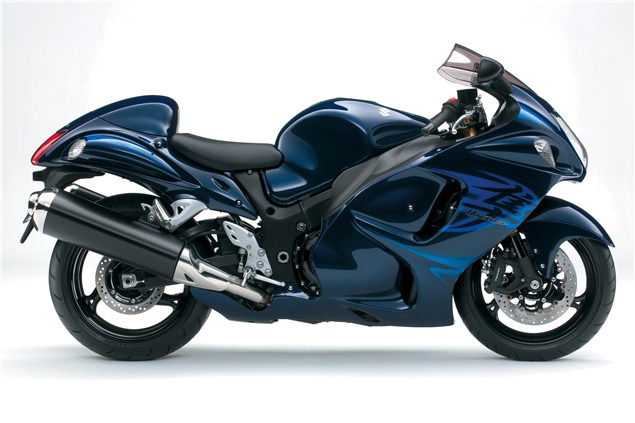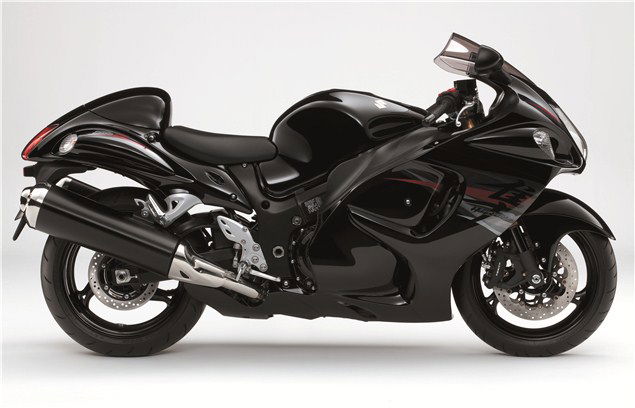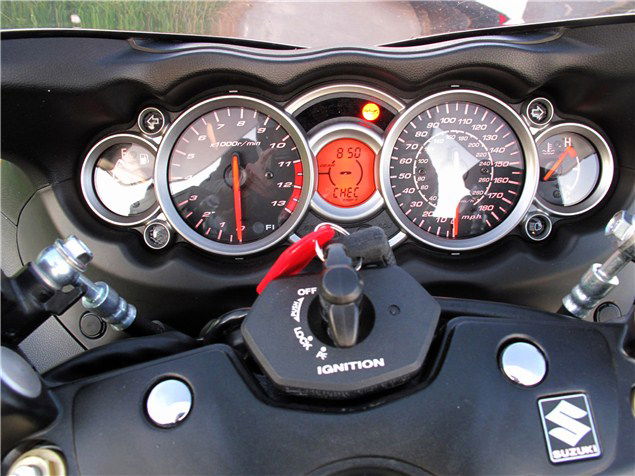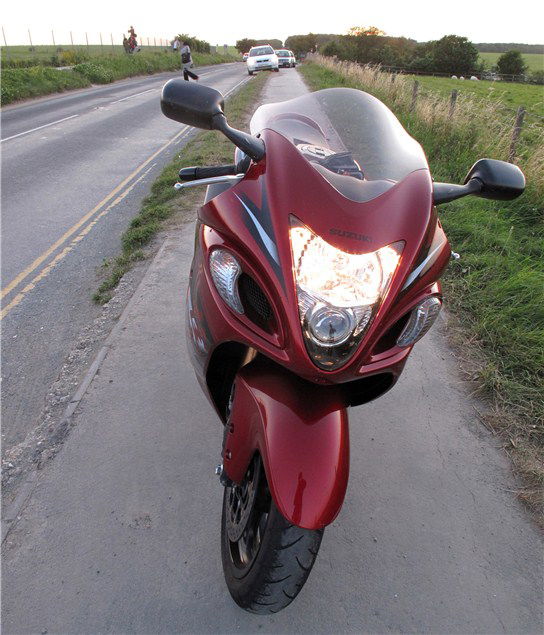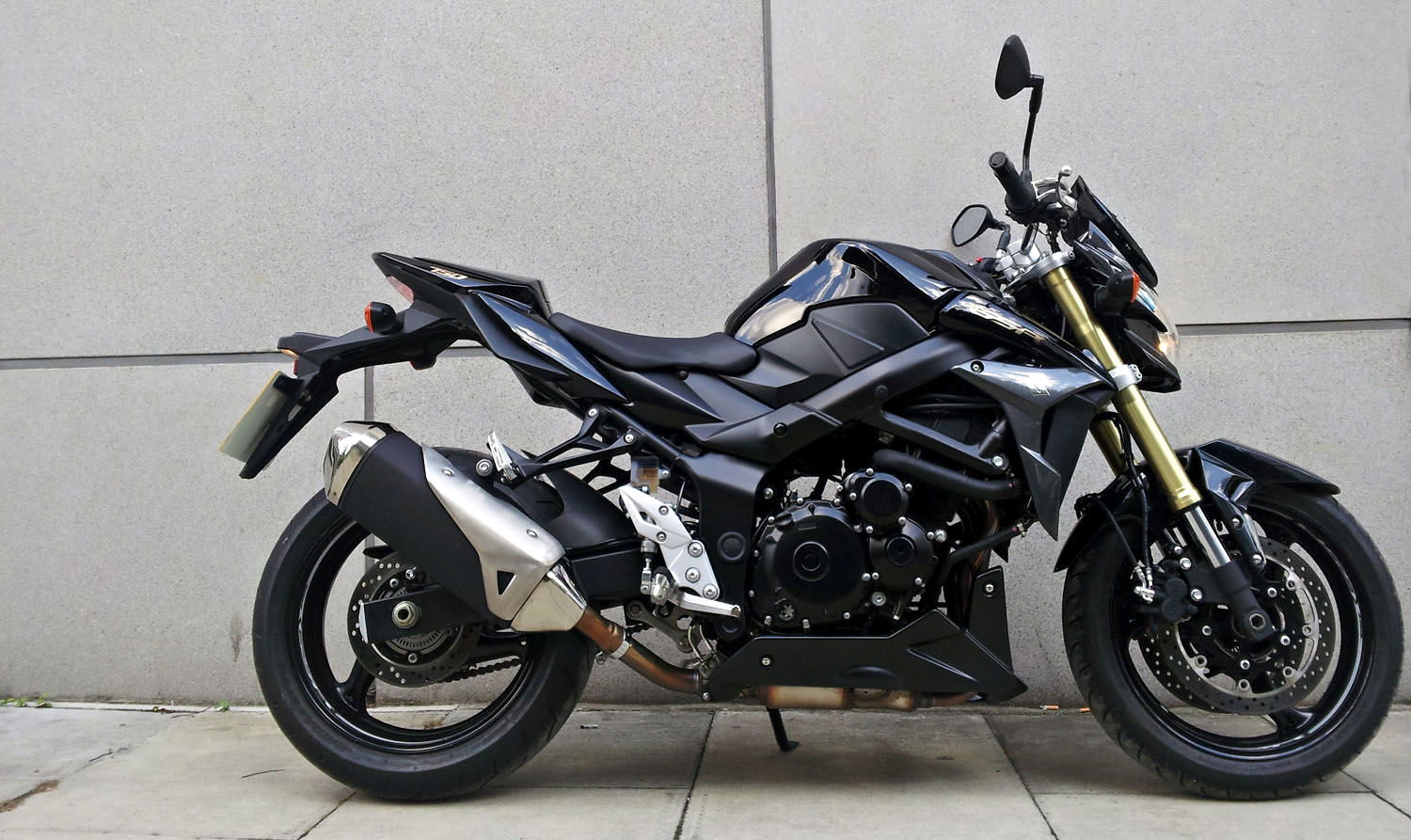2012 Suzuki Hayabusa review
Three figures speeds are the norm on Suzuki's 1340cc bruiser but is it just for straight-liners?

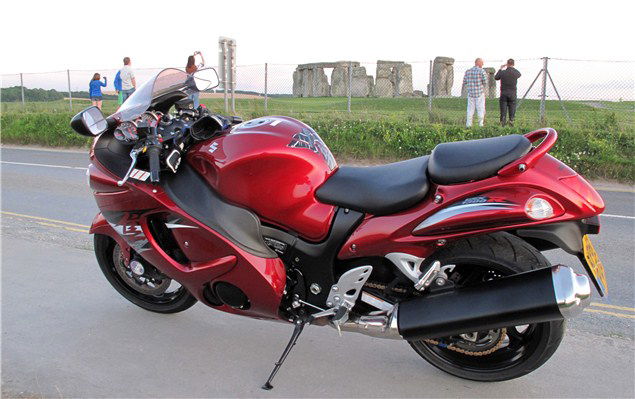
As an average bloke, what's the most likely thing that'll land you in prison? That's right, it's the 2012 Suzuki Hayabusa.
After my first half-hour on the bike, I thought I'd be writing this review from a holding cell at a police station somewhere in Buckinghamshire, as it turns out - a week later - I got away with it.
I think.
I'm not afraid to admit; this bike terrifies me. Sure, the power numbers are big: 1340cc, 180bhp, 100ftlb of torque but the real clincher in the terrifying deal is the weight: at 260kg wet, the 'Busa is a big old boy.
Those swoopy aerodynamic fairings don't do much to help it look anything but heavy and - these days - slightly dated, but even when it was first launched in 1999, I'm not sure it ever looked cutting edge.
Our test model is in Candy Sonoma Red and it's a great colour. In the rare moments of bright sunlight we get during our two-week summer, it looks stunning but that colour is to fast what slippers are to cool. Burgundy is never in danger of saying 'I'm dangerous'. A bike this size can't be subtle, but if you're in the market for a near 200mph bike, in this colour, this is about as subtle as it gets.
What is subtle about the Hayabusa are the changes its been through. While the list of changes is long, what they amount to is very little - it's still incredibly similar to the original '99 version - most changes are tiny tweaks to the engine and management system to make the bike make more power through efficiency.
Aside from its classic looks, there are two aspects of this bike that are unacceptably classic, one you can see, the other you can't.
The dash, or should I call it the instrument panel, harks back to the 90s and could do with a freshen up. From left to right it features analogue gauges: fuel gauge, rev counter, speedo and water temperature. In the centre is a small digital dash with gear indicator, clocks and the power mode you're in. I feels so old, I thought I might find a barometer in there too. Maybe that's an optional extra.
I don't mind an analogue rev-counter but I can't deal with an analogue speedo, especially on a bike this fast. You work out fairly quickly that when the needle on the speedo is pointing straight up, you're into licence-losing territory. When it comes to scrubbing off speed for a 50mph limit, you have to brake, squint at the dash and watch the needle fall to the required number then get back to the road ahead. With a large digital speedo you can just glimpse downwards, see a number and that's enough. In this day and age with the amount of GATSOs and police lasers not to mention the decreasing social-acceptance of SPEED; a 1340cc engine and tiny speedo numbers don't mix. Not unless you like the feeling of paranoia.
Now you could say: 'stop breaking the speed limit and you'll have nothing to worry about' but it's not that easy. The 'Busa goes everywhere fast. Deceptively fast.
Yes, litre superbikes are starting to make more power than the Busa, but at least they put out a bit of a wheeze and bang and make you aware you're marching into dangerous territory. The 'Busa racks up speed with an alarming lack of effort and a eery lack of noise. Two short twists of the throttle and you're doing 120mph. Get busted by the Community Speed Liason Officer at that speed and you'll make him a local hero.
If I was designing the 'Busa's clocks - or any bike's for that matter- I'd make the speed readout the main focus, with digital numbers as tall as your middle-finger. You don't need to know what gear you're in or what revs you're doing. Just what speed you're doing and how much fuel you've got left. If you could set them, so they turn red at a certain number, then you'd have a bit more awareness of your speed. These days, one or two miles an hour can make all the difference.
Despite this being 2012 and basic household items like toasters and hairdryers having some form of electronic aid, the Hayabusa still doesn't feature traction control.
Now, Suzuki either truly believe you don't need it (worrying) or their marketing department are trying to make the best of what they've got in these austere times (most likely). When it comes to the GSX-R1000, Suzuki told us to channel our inner Simon Crafar and embrace the lack of electronic aids. Try as I might, I coudn't, so I opted for a ZX-10R instead and when the going gets tough, I let the calculator do the talking.
I'm not saying you need traction control to have a good motorcycle, you don't. In the same way your toaster doesn't need an auto-pop-up function to make the perfect bit of toast but as a bloke who's more than capable of turning a slice of bread into coal, if I was buying a 200-mph motorcycle, I'd want something in there to protect me from myself.
You might think traction control comes into its own to stop you having a 100mph highside down a country road - and seeing as you don't ride like a nob, you don't need it. Well, yes, I can see your point, but.. If you crash a bike like this it'll most likely be at 27mph off a greasy roundabout just down the road from your house and that's why I rate traction control.
Despite its long wheelbase and crisp fuelling, the 'Busa has the potential to catch you out. For those of you who like your biking raw and ungoverned, you could always switch it off. If it had it.
On the go the 'Busa feels every bit as heavy as its 260kg weight suggests but it's not all bad. It feels settled and doesn't react to the road in an animated way like a sportsbike. On a country road it's not a frantic ride, it feels docile and measured.
Once you get it north of the national speed limit, it feels like it starts to get into a groove. At sensible speeds the front end feels precise for a bike of this size and it'll tip into a corner without a protest, but go into that corner a bit hot and you can notice the weight pushing on the front. The rear at speed feels slightly soft and I daresay I'm lighter than the average Hayabusa owner too. If you're going to use your Hayabusa for Sunday blasts, a couple of clicks more rebound and compression both front and rear helps the bike feel more precise. For everyday road riding, I'd be happy with it as it is.
The bike doesn't feel over-braked, while the front brakes are strong, you're often scrubbing off more speed than you might normally carry due to the way the 'Busa racks it up with little effort. You can feel the weight of the bike when you initially get on the brakes but I'd have a little more confidence to grab a handful and really see what they're all about if I had ABS as a safety net. I wouldn't fancy my chances if I had to scrub off a load of speed on a damp road as it takes that initial bite to get the 'Busa's hefty weight over the front before you can really get to work and pile on he pressure.
I took the Hayabusa on a 150-mile round-trip to watch the sun go down over Stone Henge. While it is comfortable on longer trips, it's still got a sportsbike-like riding position and that screen could do with being taller to aid wind protection. It's roomy but surprisingly it's not as comfortable as a more upright bike like the Tiger 1200.
In top gear it'll happily cruise at 110mph without a fuss. Infact it's a challenge to keep it under three figures. Ironic then, that the easiest thing to read on the dash is the digital gear indicator and with an engine this good, you'll never be bothered about what gear you're in.
Although a good bike, the Hayabusa feels like it comes from an era that no longer applies. When it came out in 1999, if you wanted to do 190mph it was the only real choice. Today, if I was heading across borders every other week and I wanted a proper engine, I'd pick a GTR1400 which offers much better wind protection, a more comfortable riding position and panniers. If I wanted to do 180mph, I'd pick a litre-class superbike. If I needed to regularly shake-off a 150-miler with ease, the Hayabusa is a good choice but its formerly unique selling points are under threat; rivalled by a host of adventure tourers like the Crosstourer, big nakeds like the GSF1250 and sports-tourers like the K1300S.
Despite bikes like the ZZR-1400 being technologically more advanced and easier to live with day to day, the Hayabusa remains the cult bike in this class and one you owe it to yourself to ride.
Self control is evidently what you need if you're going to buy one. I've never thought so much about prison as I have during the week I've had the Hayabusa and feel lucky to be handing it back rather than having it confiscated from me.
It might come from a bygone era but it's still a different kind of fast.
Price: £10,935
